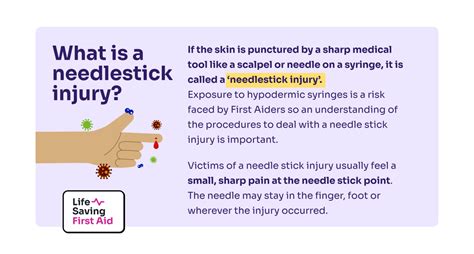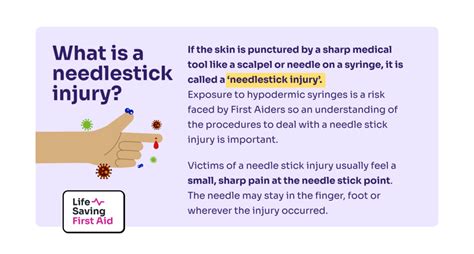Intro
The risk of needle stick injuries is a significant concern for healthcare workers and individuals who handle sharp medical instruments. These injuries can occur in various settings, including hospitals, clinics, and research laboratories, and can have serious consequences, including the transmission of bloodborne pathogens. The importance of preventing needle stick injuries cannot be overstated, as it is crucial for protecting the health and well-being of healthcare workers and preventing the spread of infectious diseases.
Needle stick injuries are a common problem in the healthcare industry, with thousands of cases reported each year. According to the Centers for Disease Control and Prevention (CDC), there are approximately 385,000 needle stick injuries that occur annually in the United States alone. These injuries can result in the transmission of bloodborne pathogens, including hepatitis B, hepatitis C, and human immunodeficiency virus (HIV). The risk of transmission is significant, with estimates suggesting that the risk of HIV transmission from a needle stick injury is around 0.3%, while the risk of hepatitis B transmission is around 6-30%.
The prevention of needle stick injuries requires a multi-faceted approach that involves the use of safe needles and syringes, proper training and education, and the implementation of effective safety protocols. Healthcare workers must be aware of the risks associated with needle stick injuries and take steps to minimize their exposure to sharp medical instruments. This includes using personal protective equipment, such as gloves and masks, and following proper procedures for handling and disposing of sharp objects.
Causes and Risk Factors of Needle Stick Injuries

Some of the most common risk factors for needle stick injuries include:
- The use of hollow-bore needles, which are more likely to cause injury than solid-bore needles
- The use of needles with a larger gauge, which are more likely to cause injury than smaller gauge needles
- The failure to use safety needles and syringes, which are designed to reduce the risk of injury
- The lack of proper training and education, which can increase the risk of injury
- The failure to follow proper procedures for handling and disposing of sharp objects, which can increase the risk of injury
Prevention Strategies for Needle Stick Injuries
The prevention of needle stick injuries requires a comprehensive approach that involves the use of safe needles and syringes, proper training and education, and the implementation of effective safety protocols. Some of the most effective prevention strategies include: * The use of safety needles and syringes, which are designed to reduce the risk of injury * The implementation of proper procedures for handling and disposing of sharp objects, such as the use of sharps containers and the proper disposal of needles and syringes * The provision of proper training and education, which can help to reduce the risk of injury by teaching healthcare workers how to properly handle and dispose of sharp medical instruments * The use of personal protective equipment, such as gloves and masks, which can help to reduce the risk of exposure to bloodborne pathogensConsequences of Needle Stick Injuries

The transmission of bloodborne pathogens is one of the most significant consequences of needle stick injuries. According to the CDC, the risk of transmission is as follows:
- HIV: 0.3%
- Hepatitis B: 6-30%
- Hepatitis C: 1.8%
Treatment and Management of Needle Stick Injuries
The treatment and management of needle stick injuries require a comprehensive approach that involves the provision of immediate care, the administration of post-exposure prophylaxis (PEP), and the follow-up of the injured worker. Some of the most effective treatment and management strategies include: * The provision of immediate care, including the cleaning and dressing of the wound * The administration of PEP, which can help to reduce the risk of transmission of bloodborne pathogens * The follow-up of the injured worker, including the provision of counseling and support * The implementation of safety protocols to prevent future injuriesPrevention of Needle Stick Injuries in the Workplace

Regulations and Guidelines for the Prevention of Needle Stick Injuries
There are several regulations and guidelines that govern the prevention of needle stick injuries in the workplace. Some of the most notable regulations and guidelines include: * The Occupational Safety and Health Administration (OSHA) Bloodborne Pathogens Standard, which requires employers to implement safety protocols to prevent the transmission of bloodborne pathogens * The CDC Guidelines for the Prevention of Needle Stick Injuries, which provide recommendations for the prevention of needle stick injuries in the workplace * The American Nurses Association (ANA) Position Statement on Needle Stick Injuries, which provides recommendations for the prevention of needle stick injuries in the workplaceConclusion and Future Directions

As we move forward, it is essential that we continue to prioritize the prevention of needle stick injuries and work towards creating a safer and healthier work environment for all healthcare workers. This can be achieved through the development of new technologies and products, such as safety needles and syringes, and through the implementation of effective safety protocols and regulations.
What is a needle stick injury?
+A needle stick injury is a type of injury that occurs when a sharp medical instrument, such as a needle or syringe, punctures the skin and potentially transmits bloodborne pathogens.
How common are needle stick injuries?
+According to the CDC, there are approximately 385,000 needle stick injuries that occur annually in the United States alone.
What are the consequences of a needle stick injury?
+The consequences of a needle stick injury can include the transmission of bloodborne pathogens, such as HIV, hepatitis B, and hepatitis C, as well as the development of post-traumatic stress disorder (PTSD) and other mental health problems.
We hope that this article has provided you with a comprehensive understanding of the importance of preventing needle stick injuries and the steps that can be taken to reduce the risk of injury. We encourage you to share this article with others and to take action to prevent needle stick injuries in your workplace. If you have any questions or comments, please don't hesitate to reach out to us.
